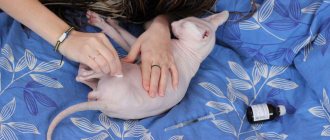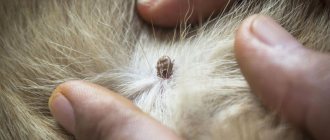Poisoning is a dysfunction of the digestive organs and other systems as a result of toxic substances entering the body through nutritional or other means. This pathology is becoming a frequent reason for visiting a veterinarian. The appearance of typical symptoms of poisoning is a reason to visit a specialist, as the consequence can be the development of severe complications and even death. But in the first stages of pathology development, high-quality pre-medical care should be provided. In order to know what to do if a cat is poisoned, you need to familiarize yourself with the possible causes and clinical manifestations of the disease.
Types and causes of poisoning
Depending on the route of entry of toxins into the body, nutritional and non-nutritive poisoning is distinguished.
- Nutritional poisoning occurs as a result of toxins entering the cat’s body when ingesting food or other substances, while the compounds are absorbed into the blood through the mucous membranes of the gastrointestinal tract. The etiological factor may be:
- eating low-quality food, which can lead to damage to internal organs as a result of exposure to flavorings, preservatives and other harmful substances;
- An unbalanced diet, for example, eating dog food, can lead to various metabolic disorders, and an excess of protein compounds in the diet causes various kidney pathologies. In addition, fried, smoked, spicy foods pose a danger;
- a cat eating poisoned rodents, for example, rat poison;
- penetration of household chemicals and other toxic compounds into the pet’s body.
- Non-nutritive poisoning is characterized by the development of intoxication syndrome in an animal as a result of damage to internal organs by compounds that enter through the mucous membranes of the eyes, nose, mouth, and respiratory tract. This category of intoxication includes damage to internal organs due to inhalation of carbon monoxide, which, combining with hemoglobin in the blood, disrupts gas exchange in tissues and leads to the development of hypoxia and death in the absence of medical care.
Can human medications be used to treat cats?
No no and one more time no! This is extremely dangerous for the animal for several reasons:
- A cat's body is structured completely differently than a human's. And even the easiest remedy can lead to the death of a cat. For example, iodine, which humans use to treat cuts, is poisonous to cats. No-spa and other antispasmodics are no less dangerous: they cause a sharp drop in pressure and can lead to the death of the animal.
- Drugs for humans are designed for human body weight. Animals with a body weight several times smaller will react completely differently to medications, even in the smallest dosages.
It is better to give any medicine to a cat only after consultation with a specialist.
If you can’t quickly get an appointment, at least find out the veterinarian’s phone number so that he can quickly advise you on how to help your pet. On a note!
You can assemble a standard set of medications for cats yourself. But it is better to take the advice of an experienced veterinarian. He'll tell you. What medications will your animal need based on its weight, breed and body characteristics?
Non-standard poisoning
Rarely occurring types of poisoning include:
- intoxication with medications - occurs when the maximum permissible dosage of the drug is exceeded, as well as if the animal has an individual intolerance or an allergic reaction to the active component of the drug;
- poisoning with various poisons. Most often, the etiological factor is rat poison, and the cat develops clinical signs of intoxication, as well as specific symptoms depending on the type of poison. If there are anticoagulants in rat poison, the cat may die from internal bleeding as a result of a disruption in the functioning of the blood coagulation system;
- poisoning with household chemicals is accompanied by dyspeptic disorders in the form of nausea and vomiting with the release of foamy stomach contents, as well as general malaise;
- Poisoning by poisonous plants is most often seasonal and observed in animals with access to the street. At home, exposure to toxic substances can occur when your pet eats azaleas, begonias, tulips, and dracaena;
- prolonged inhalation of harmful carbon monoxide leads to the formation of carboxyhemoglobin, which interferes with the exchange of oxygen in the blood and tissue, resulting in hypoxia. The animal suffers from depression of the central nervous system, and without medical attention death occurs;
- insect or snake bites are most often recorded in spring and summer. In the case of a bee sting, the affected area becomes markedly swollen and hyperemic. Your pet may develop a fever and develop anaphylactic shock. The bite of a poisonous snake disrupts the functioning of the blood coagulation system, as a result of which the animal can die from multiple hemorrhages in vital organs, as well as due to the development of disseminated intravascular coagulation syndrome.
Negative effects
The drug is well tolerated by cats and no side symptoms were noted while taking it. In exceptional cases, when using Linex, an allergic reaction may occur due to hypersensitivity. Then you will need to stop therapy and replace the probiotic with another, no less effective medicine.
If a cat is allergic to live bacteria, then you will need to select a replacement with a different list of active ingredients in the composition, but also having a similar effect on the pet’s body. For example, “Bifiform”, “Laktovit forte”, “Micerol”.
How to understand that a cat has been poisoned
The clinical picture of poisoning depends on the etiological factor. On average, signs of intoxication manifest themselves after 2-6 hours. In case of food poisoning, dyspeptic disorders in the form of nausea, vomiting and diarrhea are observed. General malaise is also noted: the animal becomes lethargic, inactive, appetite decreases, and drowsiness may appear. When eating low-quality food, vomiting, as a rule, brings relief, develops in the first hour, and consists of pieces of undigested food without pathological impurities. When pathogenic bacteria enter a cat's body along with food, a rise in body temperature and frequent stools characterized by a watery consistency are possible; in some cases, an admixture of blood is detected in the stool.
Poisoning with various poisons is accompanied by vomiting, as well as depression of the central nervous system. The clinical picture is represented by general malaise, lethargy, possible development of convulsive syndrome, impaired consciousness, coma. Rat poison leads to the formation of a blood clot in the vascular cavity as a result of disruption of the functioning of the coagulation system. There are also numerous hemorrhages in the internal organs, which can result in the rapid death of the pet. In some cases, increased salivation and foaming at the mouth may occur. Damage to the central nervous system leads to the development of convulsive syndrome and loss of coordination. Severe poisoning ends in coma and death.
General signs of intoxication syndrome include lethargy, refusal to eat, decreased mobility, changes in behavior - the animal becomes restless and agitated. Upon examination, increased heart rate and respiration are detected.
What to do in case of emergency?
- Remain calm and assess the situation for any additional threats to you or your pet.
- Keep the cat as calm as possible and keep its movements to a minimum, especially if it has possible trauma, broken limbs, or other neurological symptoms.
- Contact veterinary help, inform them of the situation and obtain first aid instructions.
- To transport your cat safely, use a suitable container or carrier for cats (it is best to remove the lid of the container to avoid accidentally injuring the cat through a small door or opening). Cover the cat with a towel or blanket. Also use some type of cloth (towel) to stabilize the animal's neck and spine.
- Take your cat to the clinic as quickly as possible, but use reasonable caution!
Diagnostics
When the first symptoms of poisoning appear, you should contact your veterinarian. The specialist will conduct an initial examination of the animal and prescribe additional research methods.
- A physical examination of the cat may reveal general malaise of the pet, an increase in heart rate and breathing, changes in the oral mucosa, and redness of the conjunctiva of the eyes. Palpation of the anterior abdominal wall in case of food poisoning determines an increase in the size of the abdomen, bloating, and rumbling along the intestines.
- A clinical blood test is prescribed to identify pathological changes. For example, an increase in the level of leukocytes and an acceleration of ESR indicates the presence of an inflammatory process in the body.
- If intoxication is suspected as a result of hemolytic poisons entering the body, a coagulogram is prescribed.
- X-ray of the abdominal organs evaluates the condition of the internal organs. This type of study can reveal the presence of pathological processes in the gastrointestinal tract, heart, lungs, and genitourinary system.
- A study of the stomach contents is carried out to determine the etiological factor of intoxication.
Causes of feline dysbiosis.
A cat, like a person, can suffer from this disease. And owners should consider the potential causes of this disease in their cat. They can be both biochemical and psychological. The first include exposure to various antibiotics and harmful bacteria. To the second:
- cases of moving to a new home,
- in situations when another animal appears in the apartment,
- in cases where the cat stays for a long time in a special hotel for animals.
One way or another, the cat is stressed. Against this background, the microflora in her intestines is disrupted. Owners understand this when their cat has frequent loose stools, vomiting or constipation. She needs urgent help. In such a situation, veterinarians give advice - give Linex to cats.
Mr. Cat recommends: first aid for a cat in case of poisoning
In case of poisoning of a pet with poor-quality food, it is necessary to remove toxins from the stomach; to do this, it is necessary to provoke a gag reflex by taking specialized medications, which include Detox, Apomorphine. The procedure allows you to speed up the removal of harmful substances from the body. Also, to cleanse the stomach, you can use lavage using a special solution: pouring a mixture of potassium permanganate and table salt diluted in water into the animal’s oral cavity will help provoke vomiting.
Also, for food poisoning, the introduction of hydrogen peroxide dissolved in water is effective. The procedure allows you to neutralize toxins from food. The ratio of ingredients should be 1:1.
Another method of gastric lavage is to inject water into the cat’s mouth with the addition of chamomile tincture; manipulation can be carried out using a small syringe without a needle.
To eliminate diarrhea, you can use Enterosgel sorbent. The drug effectively removes toxins from the intestinal lumen and also strengthens the consistency of stool.
If the animal is unconscious, a pulse cannot be felt in the peripheral arteries, and there is no movement of the respiratory muscles, cardiopulmonary resuscitation should be started, but, according to statistics, the effectiveness of the measure is less than 25%.
If your animal has signs of depression of the central nervous system and other symptoms of severe poisoning, you should contact a veterinarian.
Purpose and possible restrictions
Veterinarians recommend giving your cat Linex to treat intestinal dysbiosis, prevent and treat frequent loose stools caused by viral or bacterial infections of the gastrointestinal tract, and take antibacterial medications. "Linex" perfectly eliminates nausea, stops the urge to vomit, and painful discomfort in the stomach. A probiotic is considered the safest medicine possible, so there are practically no contraindications to taking it. The only limitation to the use of Linex is individual intolerance to any substance from its composition. The medication is absolutely safe for pregnant and lactating females.
How to help a cat with food poisoning at home and in the clinic
Helping your pet with poisoning at home involves accelerating the elimination of toxins from the body, as well as relieving symptoms.
- If an animal is poisoned by an acid, it is necessary to give an alkaline solution as an antidote; for this you can use soda diluted in water. Using egg yolks mixed with plain water is also effective.
- In case of alkali poisoning, the antidote is acid. The most accessible compounds in this group include acetic acid. The ingredient should be mixed with water in a ratio of 2 to 1 and poured into the pet’s mouth using a small syringe without a needle.
- You can induce vomiting at home by administering an aqueous solution of chamomile and potassium permanganate tincture.
- To replenish fluid deficiency and restore water and electrolyte balance, your cat should drink plenty of fluids.
- To reduce the harmful effects of toxic compounds on the cat’s body, it is recommended to give the animal sorbents. This group of products includes activated carbon, Enterosgel, Polysorb.
After completing all the necessary procedures, you should contact your veterinarian. Depending on the etiology of poisoning, the doctor will select the necessary treatment tactics.
In a hospital setting, gastric lavage is performed in order to eliminate the effect of the toxin and speed up its elimination from the body. The animal is also prescribed laxatives, sorbents and diuretics. These drugs eliminate intoxication syndrome and remove metabolites.
In case of severe poisoning with poisons that cause damage to the mucous membrane of the gastrointestinal tract, surgical therapy may be prescribed using organ resection or wound suturing.
In case of a snake bite, the doctor administers an antidote that prevents intravascular coagulation.
When the central nervous system is depressed with the development of convulsive syndrome, various anticonvulsants are used.
How to treat a cat's wound?
Wounds can be completely different deep or superficial and can have different localizations.
- If the wound is not deep and is not the result of a bite from another animal, then it is enough to treat the wound with one of the antiseptics, for example, rinse with 3% hydrogen peroxide and treat the area with common green paint (mandatory components of a veterinary first aid kit). You can apply a sterile bandage only after you are sure that the wound is dry and there is no heavy bleeding. Make sure the bandage is dry and clean. You should change the bandage once a day and monitor the condition of the wound. If any discharge appears, the color changes or there is no gradual healing, then you need to seek qualified help. It is advisable not to allow the animal to lick the injured area.
- A deep wound as a result of a bite from another animal, especially if the deep layers of tissue are affected, requires immediate surgical intervention. Therefore, you need to urgently get ready to go to the veterinary clinic. The maximum you can do is cover the affected area with a sterile piece of gauze or at least a clean cloth, and transport the animal to the clinic as soon as possible with the affected area upstairs.
What to feed your cat during and after poisoning
On the first day of poisoning, it is recommended to refuse to eat. This is due to the fact that the intake of food into the body will increase the load on the organs of the digestive tract, which can reduce the rate of elimination of toxins, and therefore worsen the prognosis of the disease. It is enough to provide the cat with enough water.
After relief of symptoms and improvement of the animal’s well-being, it is recommended to adhere to a diet.
The menu should include liquid food. Fermented milk products, egg whites, and chicken broth have a positive effect on the condition of the mucous membranes of the gastrointestinal tract.
It is not recommended to give your cat cheap food - Whiskas, Kitiket; during the rehabilitation period it is better to replace them with more expensive and high-quality analogues containing the entire necessary set of vitamins and minerals. In the future, it is also better not to feed your cat with economy class food; if you don’t have a lot of money, you can choose inexpensive options from the premium segment.
Diet therapy is usually formulated by a veterinarian based on the causes of poisoning and the current condition of the pet.
Composition and properties
Linex refers to probiotics, consisting of living cells of intestinal microflora. It is designed to treat cats that have been diagnosed with dysbiosis, accompanied by constipation, flatulence, stomach pain and vomiting. “Linex” has the following therapeutic effects on the cat’s body:
- produces metabolites that kill harmful microorganisms and antibacterial substances that stop the development of fungal and pathogenic cells;
- strengthens the immune system;
- normalizes intestinal flora;
- maintains and regulates the physiological balance of intestinal microflora;
- reduces acidity in the gastrointestinal tract;
- ensures optimal action of enzymes that break down complex food components;
- participates in the synthesis of vitamin K and group B.
The use of the combined medication "Linex" helps maintain the normal intestinal microflora of cats and restores the disturbed balance of microorganisms in the intestines.
After administration, the medicine is not detected in the systemic bloodstream, which indicates its safety.
After ingestion, the probiotic components act locally in the digestive tract. "Linex" does not penetrate into the blood, so it does not have a systemic effect. According to numerous clinical studies, in particular those conducted by E.P. Anisimova, Doctor of Veterinary Sciences, Linex is absolutely safe for cats because it does not contain toxic, carcinogenic substances.
Description and characteristics
"Bifidumbacterin" is a probiotic consisting of bifidobacteria and resists a wide range of pathogenic and opportunistic microorganisms of the gastrointestinal tract. It belongs to the means that normalize the intestinal microflora.
The drug can be produced in different forms:
- bagged powder;
- dry mass in bottles;
- dry mass in ampoules;
- capsules;
- suppositories for vaginal or rectal use.
For each case, the most appropriate form is selected, including a lot depending on the character of the cat.
"Enterol": instructions for use, price
Probiotic that normalizes intestinal microflora. Made with the yeast Saccharomyces boulardii, which competes with opportunistic and pathogenic microorganisms for space in the intestines. This opposition explains the antimicrobial effect of the drug against Klebsiella, Clostridia, Shigella, Candida, Staphylococcus, Yersinia and other pathogenic microorganisms.
Enterol is one of the few probiotics that is used to treat people and pets. Available in sachets and capsules.
Indications for use
For diarrhea, regardless of origin (viral, bacterial or stress), the instructions for use recommend using Enterol. The price of the drug is quite affordable - 10 sachets for preparing a suspension are 320 rubles. The drug is used for prophylactic purposes during antibiotic treatment.
Application and dosage
READ How to choose an automatic quail incubator
The probiotic for cats “Enterol” is used by adding it to drink (water, milk). To obtain the maximum effect, the drug is given to the animal not immediately after feeding, but after about two hours. You should know that this probiotic contains living cells, so adding it to drinks with a temperature below fifty degrees is not recommended.
The daily dose for an adult animal is one sachet per day. The dose can be divided into two doses - morning and evening. For kittens, the dosage is halved.
What factors contribute to imbalance in a cat's intestines?
There are a number of negative factors that can have a detrimental effect on a cat’s intestinal microflora.
We invite you to read: Types and causes of aggression in cats
These include:
- stress;
- poor nutrition and poor quality feed;
- vaccination;
- surgical interventions;
- inflammatory diseases of the gastrointestinal tract;
- disturbances in the functioning of the genitourinary system;
- renal failure;
- pancreatic diseases;
- taking antibacterial and steroid drugs.
The risk of dysbacteriosis in a cat increases in the following cases:
- long trips;
- changing of the living place;
- the need for the animal to stay “in foster care” with friends or in cat hotels;
- the arrival of a new family member.
The listed situations often lead to stressful conditions, and in such cases, cats’ appetite and functioning of the digestive system may be disrupted, which provokes dysbiosis.











